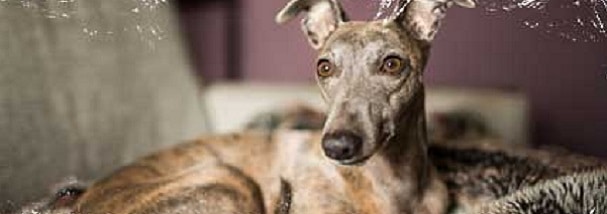 This Big Bear Award goes to Sasha for being so brave throughout all her recent treatment. Sasha is a 6 year old whippet who ruptured her Achilles tendon back in October. Her treatment has included two surgeries and months of rehabilitation.
This Big Bear Award goes to Sasha for being so brave throughout all her recent treatment. Sasha is a 6 year old whippet who ruptured her Achilles tendon back in October. Her treatment has included two surgeries and months of rehabilitation.
What happened?
The Achilles tendon is attached to the heel bone of the hind limb and is responsible for keeping the heel elevated off the ground. Sasha presented to us with a very sore hind leg and a peculiar “flat footed” stance. The diagnosis was confirmed with x-rays and it was decided to take her to surgery to repair the tendon and give her the best chance for a full recovery.
Surgery
Sasha's surgery involved two elements; first the tendon was debrided back to healthy tissue and the two ends were sewn back together. As the tendon is under a lot of tension the second part of the surgery involved placing metal pins in her leg. This holds the leg in a fixed position alleviating tension on the tendon. This is known as an external skeletal fixator (ESF) and needed to stay in place for 6 weeks giving the tendon time to heal. The surgery was successful and Sasha went home that evening.
Recovery
Sasha now had to be kept very quiet to give her tendon the best chance to heal. The bandage was removed two days after the surgery leaving the fixator in place. She coped very well with the metal frame on her leg and did not require a buster collar for more than a few days. During this time Sasha received a number of K-laser treatments to help with her pain management and wound healing. Sadly Sasha picked up a wound infection and needed a course of antibiotics to help her fight it.
Surgery two and the next step
The second surgery was to remove the pins and it went very well. This was the first time in over 6 weeks that the tendon was bearing the full weight of her leg. Over the next few weeks Sasha was allowed to increase her exercise levels very slowly to strengthen her tendon. She has also been referred to a veterinary physiotherapist to help her with her recovery regime. We will only know that the surgery has been a complete success and that her tendon is fully healed a minimum of 6 weeks after removal of the pins, 3 months after the original injury.
Conclusion
Sasha has since had a minor setback and we believe she may have a small tear in the tendon. This means she has to return to the start of her rehabilitation programme but luckily at this point does not mean further surgery. Throughout the entire process Sasha has been a fantastic patient and would not be where she is without the support of her wonderful owner. We are hopeful that with a little more time Sasha can make a full recovery and be back to full speed running out in the park.


